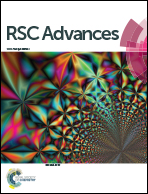Immobilized polyazomethines containing triphenylamine groups on ITO: synthesis and acidochromic, electrochemical, electrochromic and photoelectronic properties†
Abstract
A new series of polyazomethines (PAMs) containing triphenylamine (TPA) as easily-oxidized units were synthesized as highly soluble materials with electrochromism. 2,5-Bis(hexyloxy)terephthaldehyde and four different kinds of diamine were condensed to construct the PAMs under benign conditions with ![[M with combining macron]](https://www.rsc.org/images/entities/i_char_004d_0304.gif) n values of 21 700–25 400 g mol−1. The color of the PAM solution changed reversibly between light yellow and navy blue with the increase and decrease of pH. The PAMs with a high number of alkyl groups, which could dissolve facilely in many common organic solvents, were grafted onto ITO through siloxane linkages to be cast into tough films. During the electrochemical reoxidation process, the films showed color switching with high coloration efficiency. The HOMO and LUMO levels were determined via cyclic voltammograms combined with the UV-visible spectrum as −5.14 to −4.79 eV and −2.81 to −2.54 eV, respectively, which can be utilized in the hole transporting layer in organic light-emitting diodes (OLEDs) or solar cell (SC) devices.
n values of 21 700–25 400 g mol−1. The color of the PAM solution changed reversibly between light yellow and navy blue with the increase and decrease of pH. The PAMs with a high number of alkyl groups, which could dissolve facilely in many common organic solvents, were grafted onto ITO through siloxane linkages to be cast into tough films. During the electrochemical reoxidation process, the films showed color switching with high coloration efficiency. The HOMO and LUMO levels were determined via cyclic voltammograms combined with the UV-visible spectrum as −5.14 to −4.79 eV and −2.81 to −2.54 eV, respectively, which can be utilized in the hole transporting layer in organic light-emitting diodes (OLEDs) or solar cell (SC) devices.


 Please wait while we load your content...
Please wait while we load your content...